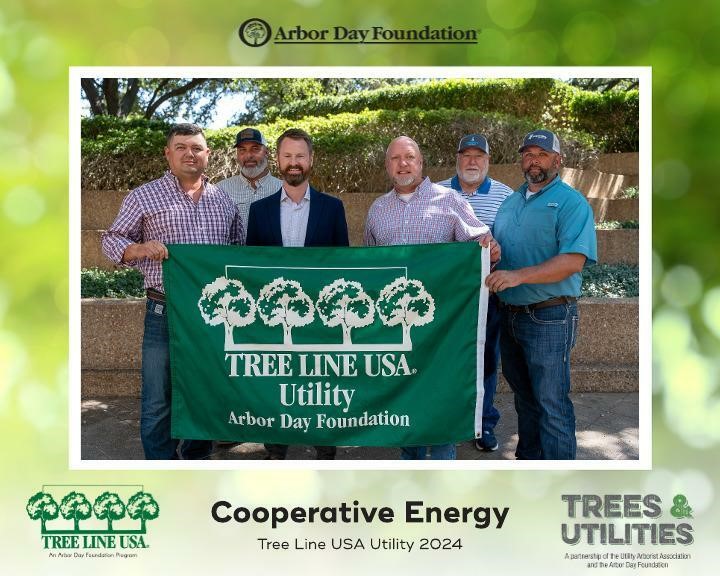What everyone should know about rights of way and vegetation management
What is vegetation management and why is it important?
Vegetation management is the process of managing trees and vegetation along Cooperative Energy’s rights of way. The mission of Cooperative Energy is to deliver reliable energy to our Members; therefore our crews must have access to our lines at all times. Overgrown rights of way can make the power restoration process harder if work equipment cannot easily access the power lines. A clear right of way helps prevent interruption of power and allows us to safely restore power faster.

What is a right of way?
In regards to electrical utility companies, a right of way is a portion of land that the utility has purchased an easement agreement to locate, construct, and maintain assets (substations, power line) within a set area. Rights of way vary in length and width, depending on several factors such as voltage of the line, terrain, and the type and size of the end-user.
Cooperative Energy maintains rights of way that are 100’ or 125’ in width, typically, but can vary in some areas. It is important that these corridors are maintained to minimize outages that can be caused by vegetation, enhance access for line crews, and minimize outage durations after storms during the restoration process. This is accomplished through mowing, tree trimming and/or removal, and herbicide application. This multi-faceted approach to vegetation management is called Integrated Vegetation Management (IVM). IVM techniques allow for Cooperative Energy to be selective in the type vegetation on the right of way, through the removal of undesirable vegetation that could threaten reliability. Being selective allows for a more herbaceous ecosystem that supports both wildlife and pollinator habitat.
Cooperative Energy maintains over 1800 miles (over 26,000 acres) of transmission right of way in 55 counties in the State of Mississippi.
Integrated Vegetation Management (IVM)
At Cooperative Energy, we use a technique called Integrated Vegetation Management (IVM) to maintain rights of way. This management tool, administered by our field biologist, utilizes various techniques to create a desirable habitat that supports not only our mission of providing reliable, efficient wholesale power safely, but wildlife and pollinator areas that are synonymous with utility corridors. Through both herbicide application and the use of mechanized equipment (mowing), undesirable vegetation such as trees and other woody growth is removed, and native grasses along with other herbaceous plant species are selected to remain and thrive on the right of way. The habitat created is ideal for various wildlife and insect species to thrive, including protected and endangered species such as the gopher tortoise (gopherus polyphemus) and black bear (ursus americanus).


Planting: the right tree, the right place
It is important that homeowners plant the right trees in the right place. Any trees that are planted too close to a power line can pose a threat and will be removed. Before planting trees next to a power line, check for two things:
1. Height- will the mature height of the tree affect the wire zone?
2. Canopy spread- how wide will the tree grow?
If you’re planning on planting, why not keep energy conservation in mind? Here’s a link to some helpful tips.
What can hunters do on a right of way?
Hunting shacks / shooting houses and deer stands are allowed on rights of way, but they have to be on the edge of the right of way so work equipment is still able to access and work on the powerlines. No attachment can be made to a power pole.
Fencing guidelines
Cooperative Energy realizes that the transmission lines we maintain cross various terrains that play host to numerous functions and operations and are owned by a wide variety of landowners. We also realize that fencing may be necessary to maintain boundaries, restrain livestock, prevent trespassing, and maintain privacy. If fencing is required, the gate opening must be 16 feet in width to provide safe clearance for the equipment. If locks are required we will request to install a company lock so that we can maintain the transmission line and right-of way. Please give us a call if you have any questions or need further information. An ROW inspector will schedule a site visit to discuss options.
Our Right of Way recognitions
Cooperative Energy has received the following recognitions for vegetation management efforts:
-
2008 Quality Vegetation Management
-
2021 Tree Line USA Recognition
-
2022 Tree Line USA Recognition
-
2022 Sam Pittman Excellence for Utility Vegetation Management Award
-
2023 Tree Line USA Recognition
-
2024 Tree Line USA Recognition
-
2025 Tree Line USA Recognition

Contact us:
If you have any questions or comments,
contact us at ROW@cooperativeenergy.com.
We’re always glad to help!

